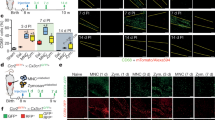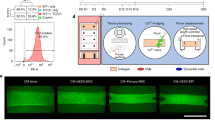Abstract
Cellular cardiomyoplasty (myogenic cell grafting) is actively being explored as a novel method to regenerate damaged myocardium. The adult human heart contains small populations of indigenous committed cardiac stem cells or multipotent cardiac progenitor cells, identified by their cell-surface expression of c-kit (the receptor for stem cell factor), P-glycoprotein (a member of the multidrug resistance protein family), and Sca-1 (stem cell antigen 1, a mouse hematopoietic stem cell marker) or a Sca-1-like protein. Cardiac stem cells represent a logical source to exploit in cardiac regeneration therapy because, unlike other adult stem cells, they are likely to be intrinsically programmed to generate cardiac tissue in vitro and to increase cardiac tissue viability in vitro. Cardiac stem cell therapy could, therefore, change the fundamental approach to the treatment of heart disease.
Key Points
-
Use of flow cytometry to sort cells with specific surface markers allows the identification of defined cell populations with an inducible differentiated phenotype and the potential for cardiac regeneration
-
Clinical translation of sorted stem cells, however, requires improved recruitment and induction by growth factors and cytokines
-
Isolation of cardiac stem cells by exploiting their functional properties (migration capacity, three-dimensional growth in culture) allows the expansion of a heterogeneous and spontaneously differentiating cell population from a very small sample
-
Clinical translation requires the isolation of cardiac stem cells from surgical or biopsy samples, ex vivo expansion, and reinjection into the damaged heart for autologous cell cardiomyoplasty
-
The three-dimensional self-organization of the cardiac stem cells in culture, comprising a core of proliferating progenitor cells protected by external layers of more-differentiated cells, allows a physiologic relationship between the cells and their environment
-
The three-dimensional organization of the cardiac stem cells could improve their survival and engraftment, once injected into the damaged heart
This is a preview of subscription content, access via your institution
Access options
Subscribe to this journal
Receive 12 print issues and online access
$209.00 per year
only $17.42 per issue
Buy this article
- Purchase on Springer Link
- Instant access to full article PDF
Prices may be subject to local taxes which are calculated during checkout


Similar content being viewed by others
References
Anversa P et al. (2006) Life and death of cardiac stem cells: a paradigm shift in cardiac biology. Circulation 113: 1451–1463
Beltrami AP et al. (2001) Evidence that human cardiac myocytes divide after myocardial infarction. N Engl J Med 344: 1750–1757
Nadin BM et al. (2003) Phenotype and hematopoietic potential of side population cells throughout embryonic development. Blood 102: 2436–2443
Vergier B et al. (1993) Expression of MDR1/P glycoprotein in human sarcomas. Br J Cancer 68: 1221–1226
Hierlihy AM et al. (2002) The post-natal heart contains a myocardial stem cell population. FEBS Lett 530: 239–243
Martin CM et al. (2004) Persistent expression of the ATP-binding cassette transporter, Abcg2, identifies cardiac SP cells in the developing and adult heart. Dev Biol 265: 262–275
Pfister O et al. (2004) CD31− but not CD31+ cardiac side population cells exhibit functional cardiomyogenic differentiation. Circ Res 97: 52–61
Beltrami AP et al. (2003) Adult cardiac stem cells are multipotent and support myocardial regeneration. Cell 114: 763–776
Dawn B et al. (2005) Cardiac stem cells delivered intravascularly traverse the vessel barrier, regenerate infarcted myocardium, and improve cardiac function. Proc Natl Acad Sci USA 102: 3766–3771
Oh H et al. (2003) Cardiac progenitor cells from adult myocardium: homing, differentiation, and fusion after infarction. Proc Natl Acad Sci USA 100: 12313–12318
Matsuura K et al. (2004) Adult cardiac Sca-1-positive cells differentiate into beating cardiomyocytes. J Biol Chem 279: 11384–11391
Leri A et al. (2005) Cardiac stem cells and mechanisms of myocardial regeneration. Physiol Rev 85: 1373–1416
Laugwitz KL et al. (2005) Postnatal isl1+ cardioblasts enter fully differentiated cardiomyocyte lineages. Nature 433: 647–653
Cai J et al. (2004) In search of “stemness”. Exp Hematol 32: 585–598
Mouquet F et al. (2005) Restoration of cardiac progenitor cells after myocardial infarction by self-proliferation and selective homing of bone marrow-derived stem cells. Circ Res 97: 1090–1092
Messina E et al. (2004) Isolation and expansion of adult cardiac stem cells from human and murine heart. Circ Res 95: 911–921
Rossi MI et al. (2005) Multicellular spheroids of bone marrow stromal cells: a three-dimensional in vitro culture system for the study of hematopoietic cell migration. Braz J Med Biol Res 38: 1455–1462
Armstrong MT et al. (2000) Regulation of proliferation of the fetal myocardium. Dev Dyn 219: 226–236
Bates RC et al. (2000) Spheroids and cell survival. Crit Rev Oncol Hematol 36: 61–74
Cerisoli F et al. c-kit-positive cardiac stem cells (CSCs) can be generated in damaged heart from bone marrow-derived cells [abstract 13230]. Circulation 114 (Suppl 18)
Barile L et al. (2005) Engraftment, migration and functional improvement in ischemic mouse hearts injected with human cardiosphere-derived stem cells. Late-Breaking Basic Science Abstracts. Presented at the American Heart Association Scientific Sessions 2005, 2005 November 13–16, Dallas Convention Center, Dallas, TX. Circ Res doi:10.1161/01.RES.0000196463.09130.2b
Smith RR et al. (2005) Electrophysiology of human and porcine adult cardiac stem cells isolated from endomyocardial biopsies. Late-breaking developments in stem cell biology and cardiac growth regulation. Circulation 111: 1720
Pozzi D et al. Extremely low frequency magnetic field promotes differentiation of the ex vivo expanded human cardiac stem cells. Proceedings of the Biological Effects of Electromagnetic Fields 4th International Workshop: 2006 16–20 October, Crete, Greece, 928–931 (Ed. P Kostarakis), in press
Liboff AR (2004) Toward an electromagnetic paradigm for biology and medicine. J Altern Complement Med 10: 41–47
Zhadin M and Barnes F (2005) Frequency and amplitude windows in the combined action of DC and low frequency AC magnetic fields on ion thermal motion in a macromolecule: theoretical analysis. Bioelectromagnetics 26: 323–330
Korff T and Augustin HG (1998) Integration of endothelial cells in multicellular spheroids prevents apoptosis and induces differentiation. J Cell Biol 143: 1341–1352
Urbanek K et al. (2006) Stem cell niches in the adult mouse heart. Proc Natl Acad Sci USA 103: 9226–9231
Acknowledgements
This study was supported by a grant from the Ministero della Pubblica Istruzione, Università e Ricerca (MIUR) and by a grant from the Istituto Pasteur-Fondazione Cenci Bolognetti to the Department of Experimental Medicine, University of Rome “La Sapienza”.
Author information
Authors and Affiliations
Corresponding author
Ethics declarations
Competing interests
The authors declare no competing financial interests.
Rights and permissions
About this article
Cite this article
Barile, L., Chimenti, I., Gaetani, R. et al. Cardiac stem cells: isolation, expansion and experimental use for myocardial regeneration. Nat Rev Cardiol 4 (Suppl 1), S9–S14 (2007). https://doi.org/10.1038/ncpcardio0738
Received:
Accepted:
Issue Date:
DOI: https://doi.org/10.1038/ncpcardio0738
This article is cited by
-
Molecular imaging of myogenic stem/progenitor cells with [18F]-FHBG PET/CT system in SCID mice model of post-infarction heart
Scientific Reports (2021)
-
Automated Segmentation of Fluorescence Microscopy Images for 3D Cell Detection in human-derived Cardiospheres
Scientific Reports (2019)
-
The mechanistic role of oxidative stress in cigarette smoke-induced cardiac stem cell dysfunction and prevention by ascorbic acid
Cell Biology and Toxicology (2019)
-
The Biological Mechanisms of Action of Cardiac Progenitor Cell Therapy
Current Cardiology Reports (2018)
-
ATP-induced Ca2+-signalling mechanisms in the regulation of mesenchymal stem cell migration
Cellular and Molecular Life Sciences (2017)



